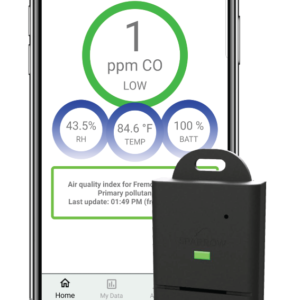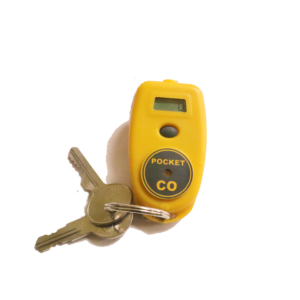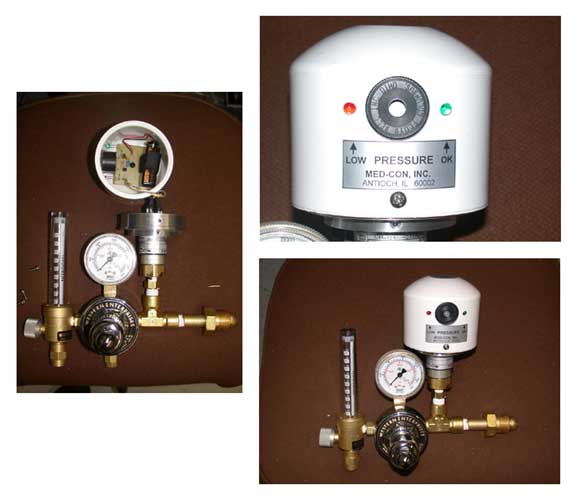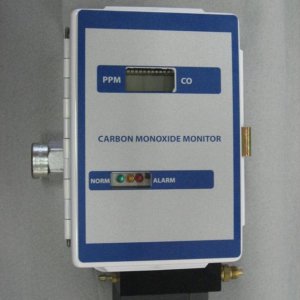Sept. 10–WEST DELAY —
A deadly wave of carbon monoxide poisonings has swept through Palm Beach County this year, prompting officials to issue alerts on how to prevent death or serious injury from the gas.
Carbon monoxide is odorless and colorless and can kill a person in their sleep without warning. Two of the main problems, officials say: A car left running in a garage and no carbon monoxide detector in the home.
“It’s just a phenomenon that’s occurring within the last 3 to 5 years,” Palm Beach County Fire-Rescue District Chief Ken Fisher said. “We’ve really gotten a lot of calls.”
So far this year in Palm Beach County, 30 people have been poisoned and three of them died, officials said. For all of last year, four people suffered carbon monoxide poisoning and two died. There were no cases in 2008, Health Department spokesman Tim O’Connor said.
It’s unclear what led to this year’s increase, he said.
Eight poisonings this year involved cars left running in garages, affecting 17 people; three involved the use of grills inside homes, affecting 11 people; and one involved a boat, affecting two people, officials said.
Responding to the increased calls about carbon monoxide poisonings, Boca Raton Fire-Rescue recently bought 25 carbon monoxide detectors to attach to paramedic equipment.
“We cut out the element of time,” fire-rescue spokesman Frank Correggio said. “Now we have a unit with us 24 hours a day. It will help save patient lives and help keep our firefighters safe.”
Last year, Boca Raton Fire-Rescue was awarded a $27,000 grant to buy 1,666 carbon monoxide detectors. They were distributed to Florida Atlantic University students and city residents at safety events.
The increase in poisonings came to fire-rescue officials’ attention after Hurricane Wilma in 2005. People were forced to go without power for days, so some ran generators too close to a window and the gas seeped inside their homes without proper ventilation. Some even used them indoors, Fisher said.
County fire-rescue officials are also planning to buy devices like those in Boca Raton that paramedics can take with them on calls.
Until then, paramedics have to be conscious of a carbon monoxide poisoning and react immediately, Fisher said. After the slew of calls, he said, paramedics check for running cars inside closed garages before entering a house.
“Right now what they’ve got is awareness,” said Fisher, who commands the area west of Delray Beach.
Sometimes the symptoms of carbon monoxide poisoning — such as sluggishness and a headache — may indicate diabetes or another medical issue, so rescuers often run into homes without knowing if carbon monoxide is inside. In the 10 to 15 minutes it takes to diagnose the patient, paramedics may get sick too. Portable detectors couldm prevent that.
On June 19, one person died and six more were injured — including three county paramedics — from carbon monoxide poisoning at a home west of Boca Raton. A car in the attached garage was left running for hours.
In 2007, two couples in two different homes died after a van was left running in the garage of one of the condos. The gas passed through the walls of the attached condo units. Neither home had a carbon monoxide detector.
“Who lit the match isn’t as important as ‘Do you live where the match was lit?'” Fisher said.
Each year, more than 400 Americans die from unintentional carbon monoxide poisoning, according to the Centers for Disease Control and Prevention, and more than 20,000 are rushed to hospitals. Only a third of American homes have a working carbon monoxide detector, according to federal statistics.
The danger has gotten the attention of Capitol Hill.
The Residential Carbon Monoxide Poisoning Prevention Act, sponsored by Sen. Amy Klobuchar, D- Minnesota, and Sen. Bill Nelson, D- Florida, is making its way through the senate.
“Our legislation would require manufacturers to build generators with automatic cutoffs when carbon monoxide is detected,” said Nelson spokesman Dan McLaughlin. “It’s important because it will save lives. Every year, especially during hurricane time, people rely on generators during power outages and every year we see deaths resulting from carbon monoxide poisoning.”
KWJ Engineering Inc. of Newark, Calif., makes keychain-sized carbon monoxide detectors they’ve sold to firefighters and other public agencies.
“You can infer you’ve got a problem because you come out tired and have a headache,” KWC production manager Larry Johnson said of the $139 devices. “But that doesn’t define anything. If you have an indicator that’s specific for carbon monoxide, then you have a clue.”
Staff Researcher Barbara Hijek contributed to this report.
Jerome Burdi can be reached at jburdi@SunSentinel.com or 561-243-6531.
. 10–WEST DELAY —
A deadly wave of carbon monoxide poisonings has swept through Palm Beach County this year, prompting officials to issue alerts on how to prevent death or serious injury from the gas.
Carbon monoxide is odorless and colorless and can kill a person in their sleep without warning. Two of the main problems, officials say: A car left running in a garage and no carbon monoxide detector in the home.
“It’s just a phenomenon that’s occurring within the last 3 to 5 years,” Palm Beach County Fire-Rescue District Chief Ken Fisher said. “We’ve really gotten a lot of calls.”
So far this year in Palm Beach County, 30 people have been poisoned and three of them died, officials said. For all of last year, four people suffered carbon monoxide poisoning and two died. There were no cases in 2008, Health Department spokesman Tim O’Connor said.
It’s unclear what led to this year’s increase, he said.
Eight poisonings this year involved cars left running in garages, affecting 17 people; three involved the use of grills inside homes, affecting 11 people; and one involved a boat, affecting two people, officials said.
Responding to the increased calls about carbon monoxide poisonings, Boca Raton Fire-Rescue recently bought 25 carbon monoxide detectors to attach to paramedic equipment.
“We cut out the element of time,” fire-rescue spokesman Frank Correggio said. “Now we have a unit with us 24 hours a day. It will help save patient lives and help keep our firefighters safe.”
Last year, Boca Raton Fire-Rescue was awarded a $27,000 grant to buy 1,666 carbon monoxide detectors. They were distributed to Florida Atlantic University students and city residents at safety events.
The increase in poisonings came to fire-rescue officials’ attention after Hurricane Wilma in 2005. People were forced to go without power for days, so some ran generators too close to a window and the gas seeped inside their homes without proper ventilation. Some even used them indoors, Fisher said.
County fire-rescue officials are also planning to buy devices like those in Boca Raton that paramedics can take with them on calls.
Until then, paramedics have to be conscious of a carbon monoxide poisoning and react immediately, Fisher said. After the slew of calls, he said, paramedics check for running cars inside closed garages before entering a house.
“Right now what they’ve got is awareness,” said Fisher, who commands the area west of Delray Beach.
Sometimes the symptoms of carbon monoxide poisoning — such as sluggishness and a headache — may indicate diabetes or another medical issue, so rescuers often run into homes without knowing if carbon monoxide is inside. In the 10 to 15 minutes it takes to diagnose the patient, paramedics may get sick too. Portable detectors couldm prevent that.
On June 19, one person died and six more were injured — including three county paramedics — from carbon monoxide poisoning at a home west of Boca Raton. A car in the attached garage was left running for hours.
In 2007, two couples in two different homes died after a van was left running in the garage of one of the condos. The gas passed through the walls of the attached condo units. Neither home had a carbon monoxide detector.
“Who lit the match isn’t as important as ‘Do you live where the match was lit?'” Fisher said.
Each year, more than 400 Americans die from unintentional carbon monoxide poisoning, according to the Centers for Disease Control and Prevention, and more than 20,000 are rushed to hospitals. Only a third of American homes have a working carbon monoxide detector, according to federal statistics.
The danger has gotten the attention of Capitol Hill.
The Residential Carbon Monoxide Poisoning Prevention Act, sponsored by Sen. Amy Klobuchar, D- Minnesota, and Sen. Bill Nelson, D- Florida, is making its way through the senate.
“Our legislation would require manufacturers to build generators with automatic cutoffs when carbon monoxide is detected,” said Nelson spokesman Dan McLaughlin. “It’s important because it will save lives. Every year, especially during hurricane time, people rely on generators during power outages and every year we see deaths resulting from carbon monoxide poisoning.”
KWJ Engineering Inc. of Newark, Calif., makes keychain-sized carbon monoxide detectors they’ve sold to firefighters and other public agencies.
“You can infer you’ve got a problem because you come out tired and have a headache,” KWC production manager Larry Johnson said of the $139 devices. “But that doesn’t define anything. If you have an indicator that’s specific for carbon monoxide, then you have a clue.”
Staff Researcher Barbara Hijek contributed to this report.
Jerome Burdi can be reached at jburdi@SunSentinel.com or 561-243-6531.
pt. 10–WEST DELAY —
A deadly wave of carbon monoxide poisonings has swept through Palm Beach County this year, prompting officials to issue alerts on how to prevent death or serious injury from the gas.
Carbon monoxide is odorless and colorless and can kill a person in their sleep without warning. Two of the main problems, officials say: A car left running in a garage and no carbon monoxide detector in the home.
“It’s just a phenomenon that’s occurring within the last 3 to 5 years,” Palm Beach County Fire-Rescue District Chief Ken Fisher said. “We’ve really gotten a lot of calls.”
So far this year in Palm Beach County, 30 people have been poisoned and three of them died, officials said. For all of last year, four people suffered carbon monoxide poisoning and two died. There were no cases in 2008, Health Department spokesman Tim O’Connor said.
It’s unclear what led to this year’s increase, he said.
Eight poisonings this year involved cars left running in garages, affecting 17 people; three involved the use of grills inside homes, affecting 11 people; and one involved a boat, affecting two people, officials said.
Responding to the increased calls about carbon monoxide poisonings, Boca Raton Fire-Rescue recently bought 25 carbon monoxide detectors to attach to paramedic equipment.
“We cut out the element of time,” fire-rescue spokesman Frank Correggio said. “Now we have a unit with us 24 hours a day. It will help save patient lives and help keep our firefighters safe.”
Last year, Boca Raton Fire-Rescue was awarded a $27,000 grant to buy 1,666 carbon monoxide detectors. They were distributed to Florida Atlantic University students and city residents at safety events.
The increase in poisonings came to fire-rescue officials’ attention after Hurricane Wilma in 2005. People were forced to go without power for days, so some ran generators too close to a window and the gas seeped inside their homes without proper ventilation. Some even used them indoors, Fisher said.
County fire-rescue officials are also planning to buy devices like those in Boca Raton that paramedics can take with them on calls.
Until then, paramedics have to be conscious of a carbon monoxide poisoning and react immediately, Fisher said. After the slew of calls, he said, paramedics check for running cars inside closed garages before entering a house.
“Right now what they’ve got is awareness,” said Fisher, who commands the area west of Delray Beach.
Sometimes the symptoms of carbon monoxide poisoning — such as sluggishness and a headache — may indicate diabetes or another medical issue, so rescuers often run into homes without knowing if carbon monoxide is inside. In the 10 to 15 minutes it takes to diagnose the patient, paramedics may get sick too. Portable detectors couldm prevent that.
On June 19, one person died and six more were injured — including three county paramedics — from carbon monoxide poisoning at a home west of Boca Raton. A car in the attached garage was left running for hours.
In 2007, two couples in two different homes died after a van was left running in the garage of one of the condos. The gas passed through the walls of the attached condo units. Neither home had a carbon monoxide detector.
“Who lit the match isn’t as important as ‘Do you live where the match was lit?'” Fisher said.
Each year, more than 400 Americans die from unintentional carbon monoxide poisoning, according to the Centers for Disease Control and Prevention, and more than 20,000 are rushed to hospitals. Only a third of American homes have a working carbon monoxide detector, according to federal statistics.
The danger has gotten the attention of Capitol Hill.
The Residential Carbon Monoxide Poisoning Prevention Act, sponsored by Sen. Amy Klobuchar, D- Minnesota, and Sen. Bill Nelson, D- Florida, is making its way through the senate.
“Our legislation would require manufacturers to build generators with automatic cutoffs when carbon monoxide is detected,” said Nelson spokesman Dan McLaughlin. “It’s important because it will save lives. Every year, especially during hurricane time, people rely on generators during power outages and every year we see deaths resulting from carbon monoxide poisoning.”
KWJ Engineering Inc. of Newark, Calif., makes keychain-sized carbon monoxide detectors they’ve sold to firefighters and other public agencies.
“You can infer you’ve got a problem because you come out tired and have a headache,” KWC production manager Larry Johnson said of the $139 devices. “But that doesn’t define anything. If you have an indicator that’s specific for carbon monoxide, then you have a clue.”
Staff Researcher Barbara Hijek contributed to this report.
Jerome Burdi can be reached at jburdi@SunSentinel.com or 561-243-6531.





